Trespassing Modernities
Salt Galata
May 8 – August 11, 2013
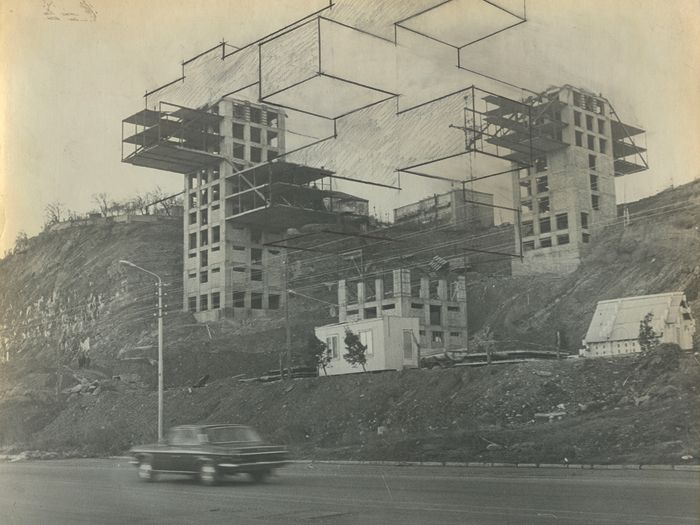
Ministery of Transportation (Tbilisi, Georgia)
Architects: George Chakhava, Zurab Jalaghania, T. Tkhilava, V. Kimberg
1974
Courtesy George Chakhava's personal archive collected and selected by Vahram Aghasyan, Nini Palavandishvili and Lali Pertenava as a part of Frozen moments. Architecture Speaks Back curated by Joanna Warsza, Tbilisi, 2010
Architects: George Chakhava, Zurab Jalaghania, T. Tkhilava, V. Kimberg
1974
Courtesy George Chakhava's personal archive collected and selected by Vahram Aghasyan, Nini Palavandishvili and Lali Pertenava as a part of Frozen moments. Architecture Speaks Back curated by Joanna Warsza, Tbilisi, 2010
Almost 25 years after the corrosion of the Soviet Union, still little is known, beyond the former Empire’s borders, about the social fabric that wove it together. Architecture and urbanism have been one of its strongest warps: creating a feeling of social unity and being one of the agents of its dissolution. This continent of architecture, afflicted by inner contradictions that enfolded within an homogenized space, is full of masterpieces waiting to be formally discovered. Trespassing Modernities explores this landscape and an approach of building for a fundamentally different idea of society.
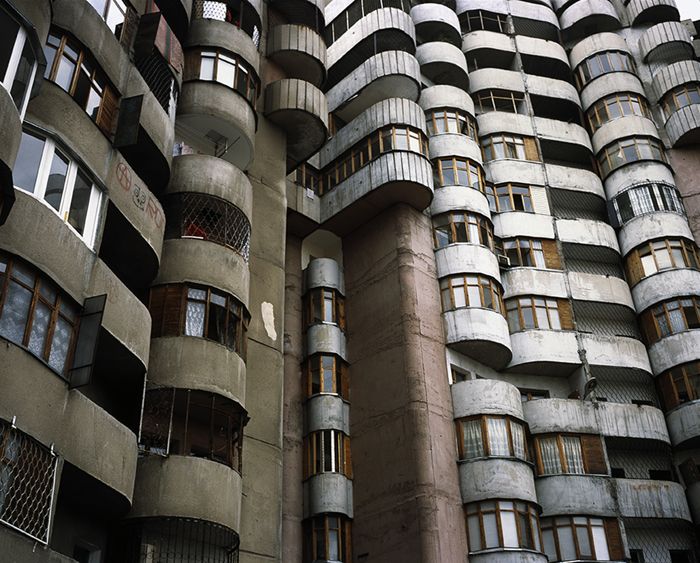
Residential complex (Almaty, Kazakhstan)
Photo: Markus Weisbeck (In the context of the project Local Modernities)
Photo: Markus Weisbeck (In the context of the project Local Modernities)
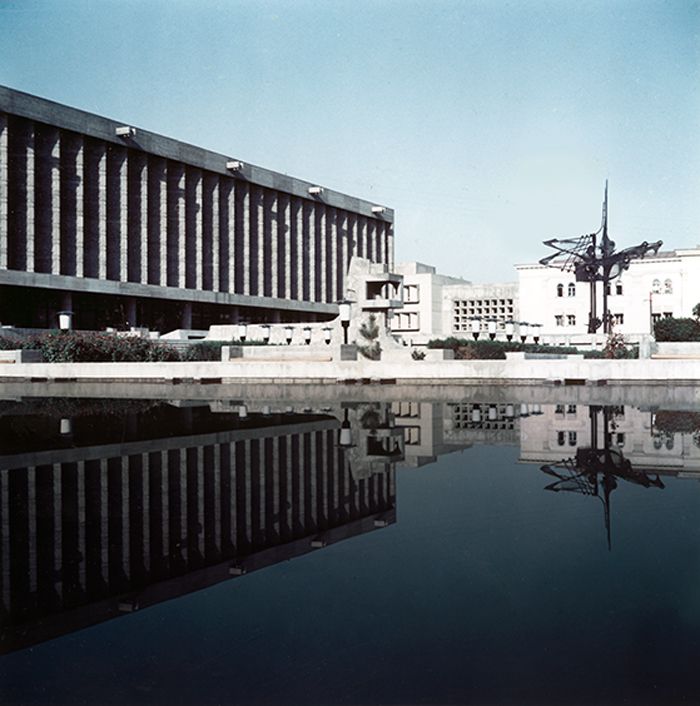
Karl Marx Library (Ashgabat, Turkmenistan)
Architects: Abdullah Akhmedov, Boris Shpak, Vladimir Alekseyev
1960-1975
Sculptor: Vadim Kosmatschof (1975)
Archive Kosmatschof
Architects: Abdullah Akhmedov, Boris Shpak, Vladimir Alekseyev
1960-1975
Sculptor: Vadim Kosmatschof (1975)
Archive Kosmatschof
All started in the thaw period of the Khrushchev years after Stalin’s death in 1953. The new ideological call for modernization of the country led to an enormous extension of urban space. This continued into the final years of the USSR as economical crisis and dwindling material resources took their toll. The master architecture of Socialist Realism was rejected. A new urbanization was driven by an ideology of scientific and technological progress. It was conceived by local planning offices in each republic and executed to the standardizations of the construction industry. Architects experimented with concepts of international architecture and the legacy of Soviet Modernism of the 1920s. Rapidly an original Soviet language of Late Modernism developed.
![“Start Industrialization!” “Start Industrialization!” [Sanayileşmeyi Başlatın!]
Afiş: Felix Novikov](/directus/media/thumbnails/1111-jpg-780-5000-false.jpg)
“Start Industrialization!”
Poster: Felix Novikov
Poster: Felix Novikov
But already in the 1960s a critical countermove to this policy of industrialization of space and architecture arose. It took the historical old town as a point of reference. Architects and local elites understood their distance to the official canon of architecture as being a confirmation of their regional – or national – search for identity. Thus an architectural avant-garde, that defied the dominant politics of the central Moscow bureaucracy, was able to form in the republics. Both versions of modernism – the local modern and the Soviet-hybrid – reflected differently positioned modern lifestyles.
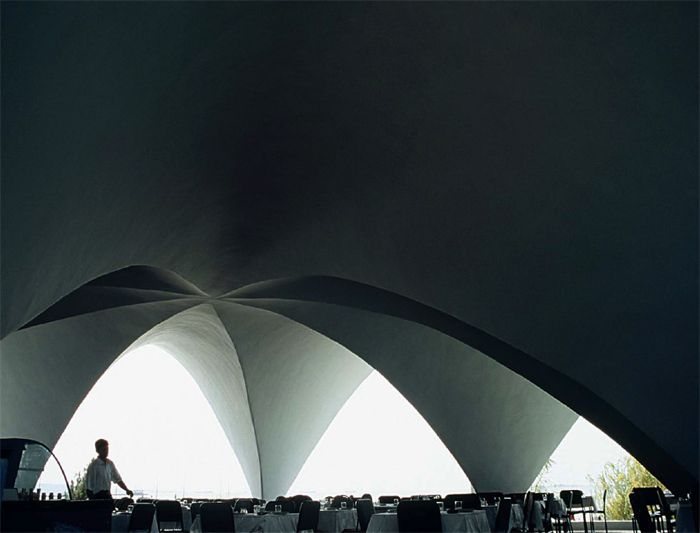
Café Zhemchuzhina (Baku, Azerbaijan)
Architects: Wadim Shulgyn, R. Şarifov, Boris Ginsburg, Avram Surkyn (Bakiprogor)
1960s
Photo: Markus Weisbeck (In the context of the project Local Modernities)
Architects: Wadim Shulgyn, R. Şarifov, Boris Ginsburg, Avram Surkyn (Bakiprogor)
1960s
Photo: Markus Weisbeck (In the context of the project Local Modernities)
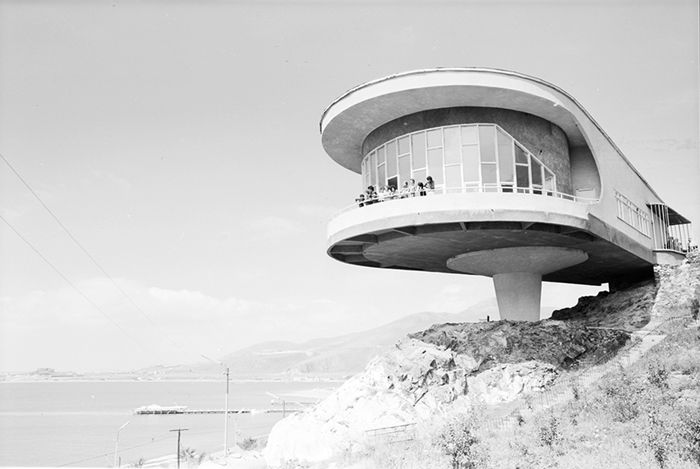
Holiday Retreat of the Union of Writers, dining hall (Sevan Peninsula, Armenia)
Architect: Gevorg Kochar (Yerevanproekt)
1965-1969
Courtesy National Archives of Armenia
Architect: Gevorg Kochar (Yerevanproekt)
1965-1969
Courtesy National Archives of Armenia
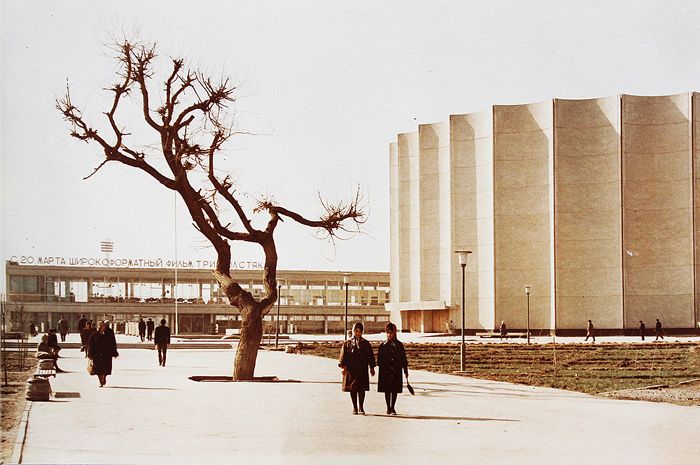
Palace of Arts (Tashkent, Uzbekistan)
Architects: Vladimir Berezin, Sergo Sutyagin, Yury Khaldeyev, Dmitry Shuvayev (UzNIIPGradostroitelstva)
1964
Archive Sutyagin
Architects: Vladimir Berezin, Sergo Sutyagin, Yury Khaldeyev, Dmitry Shuvayev (UzNIIPGradostroitelstva)
1964
Archive Sutyagin
In the course of the late 1960s and during the 1970s, there was a paradigmatic shift. Under Brezhnev, the lifestyle of the whole Soviet society had become Westernised. This could be seen in every day life and in the rush for Western commodities, but also in the decline of communist ideologies of a notion of community that architecture and urbanism responded to with singular typologies – from the pioneer camp to the houses of creativity, from the circus to the wedding palace.
The then leading modernist architects continued to build in the International Style and bore the responsibility for monotonous giant housing developments. Policies of industrialization that were heavily promoted by economic planners resulted in far-reaching social consequences. Megalomaniac urban extension projects, catering for up to 100,000 inhabitants, were built throughout the Union. In the same turn the public space was filled with monuments depicting Soviet ideology.
The then leading modernist architects continued to build in the International Style and bore the responsibility for monotonous giant housing developments. Policies of industrialization that were heavily promoted by economic planners resulted in far-reaching social consequences. Megalomaniac urban extension projects, catering for up to 100,000 inhabitants, were built throughout the Union. In the same turn the public space was filled with monuments depicting Soviet ideology.
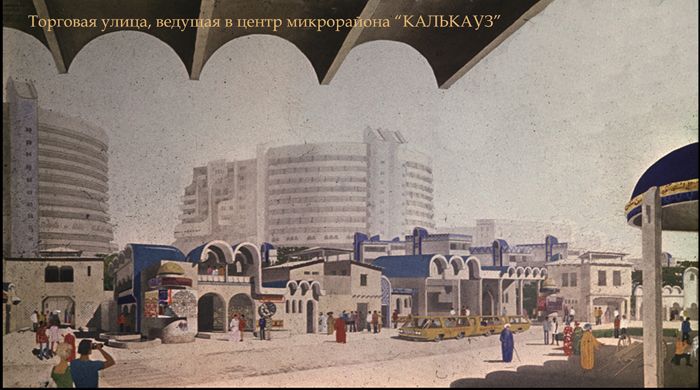
Kal’kauz, design for a prototype micro-district development (Tashkent, Uzbekistan)
Architects: Sabir Rakhimov, Andrey Kosinskiy
Project leaders: Gennady Korobovtsev, Georgy Grigoryants, et al.
1978 (unrealized)
Courtesy Andrey Kosinskiy
Architects: Sabir Rakhimov, Andrey Kosinskiy
Project leaders: Gennady Korobovtsev, Georgy Grigoryants, et al.
1978 (unrealized)
Courtesy Andrey Kosinskiy
At the end of the decade, the neo-functionalism of the early 1970s was followed by an appellative post-modernism in which the tendency towards petit-bourgeois and national counter-affirmation as a dissociation from the megalomaniac gesture and the ideological bias of Soviet architecture became visible. The perestroika movement of the critical and deconstructive “Paper Architecture” reflected this decline in their artistic utopias.
![Red Tower <i>Red Tower</i> [Kırmızı Kule]
Yuri Avvakumov, Yuri Kuzin (1987)
Gazete üstüne serigrafi baskı, 60X42cm
Yuri Avvakumov’un izniyle](/directus/media/thumbnails/1097-jpg-780-5000-false.jpg)
Red Tower
Yuri Avvakumov, Yuri Kuzin (1987)
Silk-screen print on newspaper, 60X42cm
Courtesy Yuri Avvakumov
Yuri Avvakumov, Yuri Kuzin (1987)
Silk-screen print on newspaper, 60X42cm
Courtesy Yuri Avvakumov
![Augustitorm Arhitektuuris [August Storm in Architecture] <i>Augustitorm Arhitektuuris</i> [Mimarlıkta Agustos Fırtınası]
Avo-Himm Looveer (1982)
Avo-Himm Looveer’ın izniyle](/directus/media/thumbnails/1098-jpg-780-5000-false.jpg)
Augustitorm Arhitektuuris [August Storm in Architecture]
Avo-Himm Looveer (1982)
Courtesy Avo-Himm Looveer
Avo-Himm Looveer (1982)
Courtesy Avo-Himm Looveer
Trespassing Modernities is dedicated to the legacy of post-war Soviet architecture: to its masters and its specificities, its original styles and erratic buildings. It aims to offer a glance at a still existing void in the canonical history of architecture.
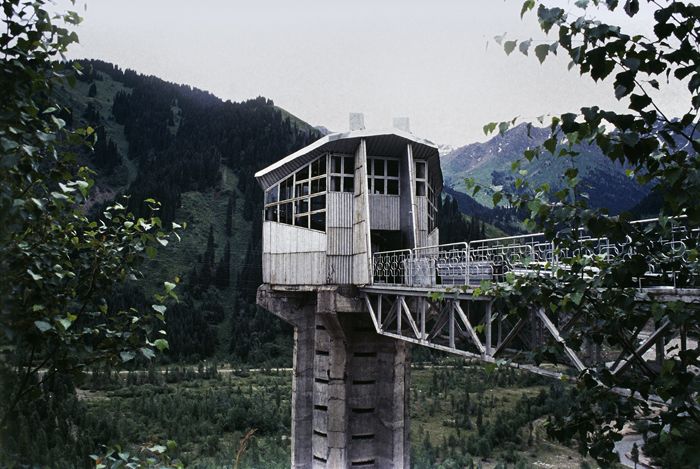
Skating Ring Medeo, Reservoir Proctorhouse (Almaty, Kazakhstan)
Architects: Vladimir Katsev, S. Kokhanovich, A. S. Kainarbayev, I. G. Kosogova (Almaty Gipragor)
1969-1972
Photo: Markus Weisbeck (In the context of the project Local Modernities)
Architects: Vladimir Katsev, S. Kokhanovich, A. S. Kainarbayev, I. G. Kosogova (Almaty Gipragor)
1969-1972
Photo: Markus Weisbeck (In the context of the project Local Modernities)
Supported by Kalebodur, Trespassing Modernities is programmed for SALT by Georg Schöllhammer with Ruben Arevshatyan. The exhibition is based on the research of Local Modernities, a project by Georg Schöllhammer, Ruben Arevshatyan, Klaus Ronneberger, Markus Weisbeck and Heike Ander, which initiated the exhibition Soviet Modernism 1955-1991 Unknown Stories (2012) by Architekturzentrum Wien.
Georg Schöllhammer is an editor, writer and curator based in Vienna. He is founding editor of springerin and head of tranzit.at. He has worked internationally on cultural projects including dOCUMENTA, Manifesta, L’internationale, Former West and Sweet 60s.
Ruben Arevshatyan is an artist, art critic, curator based in Yerevan. He has worked internationally on projects including Great Atrophy, Parallel Reality, Manuals: Subjects of New Universality (Armenian National Pavilion in 54th Venice Biennale) and “Sweet 60s.”
 The digital database of “Soviet Modernism 1955-1991” of buildings in the former Soviet republics (not including Russia) is kindly made available by Architekturzentrum Wien for browsing in the exhibition.
The digital database of “Soviet Modernism 1955-1991” of buildings in the former Soviet republics (not including Russia) is kindly made available by Architekturzentrum Wien for browsing in the exhibition.
Supported by
Georg Schöllhammer is an editor, writer and curator based in Vienna. He is founding editor of springerin and head of tranzit.at. He has worked internationally on cultural projects including dOCUMENTA, Manifesta, L’internationale, Former West and Sweet 60s.
Ruben Arevshatyan is an artist, art critic, curator based in Yerevan. He has worked internationally on projects including Great Atrophy, Parallel Reality, Manuals: Subjects of New Universality (Armenian National Pavilion in 54th Venice Biennale) and “Sweet 60s.”
Supported by
Trespassing Modernities is programmed for SALT by Georg Schöllhammer with Ruben Arevshatyan, designed by Future Anecdotes Istanbul.
Researchers
Oleksandr Burlaka, Boris Chukhovich, Olga Kazakova, Mari Laanemets, Samat Mambetshaev, Oleksiy Radynski, Yuliya Sorokina, Nano Zazanashvili
Assistants
Bahar Akgün, İdil Ateşli, Derya Karaali
Contributing individuals and groups
Elchin Aliev, Elena Antsuta, Levan Asabashvili, Yuri Avvakumov, Vasil Babayan, Orozbek Baigojoev, Alexander Barkov, Tetyana Belyaeva, Eduard Bilsky, Levon Cherkezyan archive, Vakhtang Davitaia, Ulan Djaparov, Anatoly Dobrovolsky archive, Ülevi Eljand, Artsvin Grigoryan archive, Andrey Kosinskiy, Ignar Fyuk, Shota Kavlashvili archive, Ramaz Kiknadze archive, Vadim Kosmatschof, Lev Kuchiskij, Kaarel Kurismaa, Vilen Künnapu, Stepan Kyurkchyan archive, Oleg Lazarev, Vladimir Melnichenko, Zhanna Mesheryakova, Philipp Meuser, Ruslan Muradov, Marina Naprushkina, Saken Narynov, Felix Novikov, Oleksiy Petrov, Hrachik Poghosyan, Romualdas Rakauskas, Katharina Roters, Jahangir Selimkhanov, Vladimir Shevchenko, Givi Shavdia, Yegor Shulyk, Valentyn Shtolko, Sergo Sutyagin, Artur Tarkhanyan archive, Martin Tovmasyan archive, Vladimir Vesnin, Igor Vasilevskij, Markus Weisbeck (Local Modernities), Rafik Yeghoyan; Vahram Aghasyan, Nini Palavandishvili, Lali Pertenava and Joanna Warsza (Frozen Moments. Architecture Speaks Back, Tbilisi, 2010)
Collaborating institutions
Architekturzentrum Wien, ArmProject Institute, Chmutina Charitable Fund of Architecture Development, Forma Architects -Kiev, KievZNIIEP Institute, Lithuanian Central State Archive, National Archives of Armenia, National Archives of Azerbaijan, National Archives of Georgia, National Museum – Institute of Architecture of the Ministry of Urban Development of the Republic of Armenia, State Schusev Museum of Architecture, The Museum of Estonian Architecture, TUŞPA, Union of Architects of Armenia, V. Zabolotny State Scientific Architecture and Construction Library (Kiev), Vilnius County Archive, Archive of the Institute of Architecture and Construction Kaunas, Visual Culture Research Center (Kiev), Yerevan History Museum
tranzit.at
Acknowledgements
Hayk Ayvazyan, Grigor Azizyan, Mher Cherkezyan, Alexander Chernyavskij, Marija Dremaite, Arevik Grigoryan, Ashot Grigoryan, Gohar Isakhanyan, Linda Kaljundi, Yalçın Korkmaz, Vadim Kosmatschof, Nilüfer Kozikoğlu, Lia and Armen Kyurkchyans, Mari Laanemets, Kristin-Mari Looveer, Samat Mambetshaev, Mkrtich Minasyan, Gurgen Musheghyan, Heie Treier, Katharina Ritter, Ekaterina Shapiro-Obermair, Dietmar Steiner, Anahit Tarkhanyan, Mait Väljas, Amatuni Virabyan, Garegin Yeghoyan, Alexandra Wachter
Researchers
Oleksandr Burlaka, Boris Chukhovich, Olga Kazakova, Mari Laanemets, Samat Mambetshaev, Oleksiy Radynski, Yuliya Sorokina, Nano Zazanashvili
Assistants
Bahar Akgün, İdil Ateşli, Derya Karaali
Contributing individuals and groups
Elchin Aliev, Elena Antsuta, Levan Asabashvili, Yuri Avvakumov, Vasil Babayan, Orozbek Baigojoev, Alexander Barkov, Tetyana Belyaeva, Eduard Bilsky, Levon Cherkezyan archive, Vakhtang Davitaia, Ulan Djaparov, Anatoly Dobrovolsky archive, Ülevi Eljand, Artsvin Grigoryan archive, Andrey Kosinskiy, Ignar Fyuk, Shota Kavlashvili archive, Ramaz Kiknadze archive, Vadim Kosmatschof, Lev Kuchiskij, Kaarel Kurismaa, Vilen Künnapu, Stepan Kyurkchyan archive, Oleg Lazarev, Vladimir Melnichenko, Zhanna Mesheryakova, Philipp Meuser, Ruslan Muradov, Marina Naprushkina, Saken Narynov, Felix Novikov, Oleksiy Petrov, Hrachik Poghosyan, Romualdas Rakauskas, Katharina Roters, Jahangir Selimkhanov, Vladimir Shevchenko, Givi Shavdia, Yegor Shulyk, Valentyn Shtolko, Sergo Sutyagin, Artur Tarkhanyan archive, Martin Tovmasyan archive, Vladimir Vesnin, Igor Vasilevskij, Markus Weisbeck (Local Modernities), Rafik Yeghoyan; Vahram Aghasyan, Nini Palavandishvili, Lali Pertenava and Joanna Warsza (Frozen Moments. Architecture Speaks Back, Tbilisi, 2010)
Collaborating institutions
Architekturzentrum Wien, ArmProject Institute, Chmutina Charitable Fund of Architecture Development, Forma Architects -Kiev, KievZNIIEP Institute, Lithuanian Central State Archive, National Archives of Armenia, National Archives of Azerbaijan, National Archives of Georgia, National Museum – Institute of Architecture of the Ministry of Urban Development of the Republic of Armenia, State Schusev Museum of Architecture, The Museum of Estonian Architecture, TUŞPA, Union of Architects of Armenia, V. Zabolotny State Scientific Architecture and Construction Library (Kiev), Vilnius County Archive, Archive of the Institute of Architecture and Construction Kaunas, Visual Culture Research Center (Kiev), Yerevan History Museum
tranzit.at
Acknowledgements
Hayk Ayvazyan, Grigor Azizyan, Mher Cherkezyan, Alexander Chernyavskij, Marija Dremaite, Arevik Grigoryan, Ashot Grigoryan, Gohar Isakhanyan, Linda Kaljundi, Yalçın Korkmaz, Vadim Kosmatschof, Nilüfer Kozikoğlu, Lia and Armen Kyurkchyans, Mari Laanemets, Kristin-Mari Looveer, Samat Mambetshaev, Mkrtich Minasyan, Gurgen Musheghyan, Heie Treier, Katharina Ritter, Ekaterina Shapiro-Obermair, Dietmar Steiner, Anahit Tarkhanyan, Mait Väljas, Amatuni Virabyan, Garegin Yeghoyan, Alexandra Wachter

